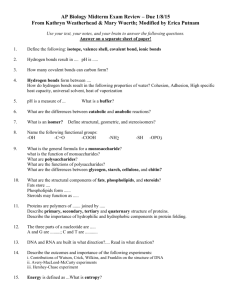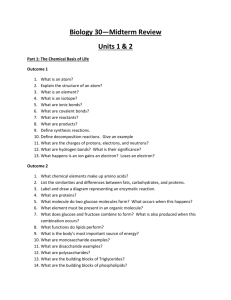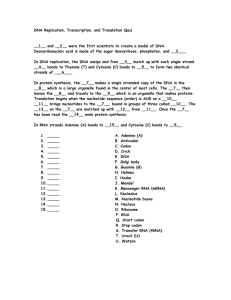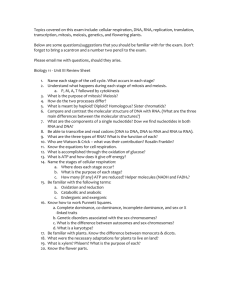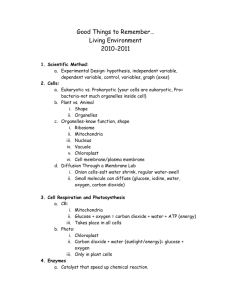EOC - Review
advertisement
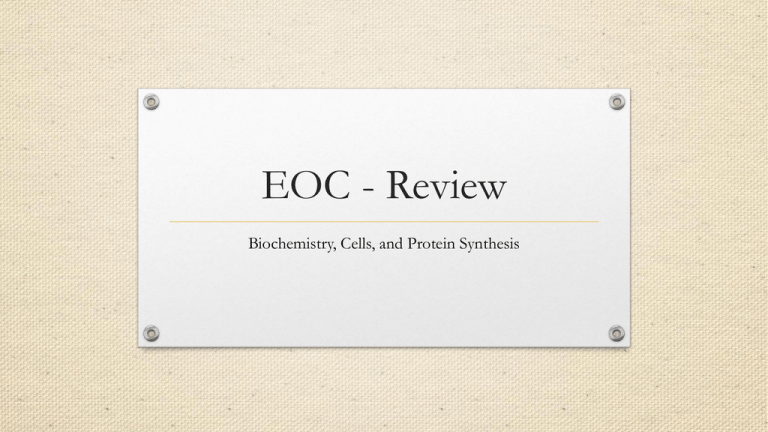
EOC - Review Biochemistry, Cells, and Protein Synthesis Biochemistry • Question #1 • Atomic Number = Number of protons • Mass Number = Number of protons and neutrons • To find the number of protons or neutrons just subtract • Question #2 • Ions can more easily dissolve in solvents and combine with other ions of opposite charge • Question #3 • The bigger the difference in relative charges the higher the polarity • Question #4 • Covalent bonds form between two non-metals • Ionic bonds form between a metal and a non-metal • Question #5 • Carbon can form up to 4 covalent bonds • Question #6 • The balanced chemical equation for cellular respiration is C6H12O6 + 6O2 6CO2 + 6H2O • Question #7 • All other answers are traits of organic compounds, except they form covalent bonds • Question #8 • pH scale cheat sheet: • The number of hydrogen ions goes down by a factor of 10 for every pH number • The number of hydroxide ions goes up by a factor of 10 for every pH number • Acids are below 7 in pH; Bases are above 7, 7 is neutral • Question #9 • Induced Fit Model – Enzyme and substrate bond at the active site. Bonding causes a slight change in shape which puts pressure on chemical bonds so they break easier • Question #10 • If Enzyme X is inhibited (stopped) then every chemical reaction AFTERWARDS is affected • Question #11 • Enzymes speed up chemical reactions by lowering the activation energy • This speeds up the reaction time • Question #12 and #13 • • • • Properties of water Adhesion and cohesion – water is attaches well to other water molecules and surfaces Polar – The oxygen part is slightly negative, hydrogens slightly positive High specific heat – it takes a lot of energy to raise water’s temperature Cells • Question #1 • Prokaryotic Cells have no nucleus and no membrane bound organelles • Questions #2 and #3 • Use the flashcards on Quizlet.com to practice organelle functions • Question #4 • Actin depolymerizes (unwinds) the microtubule arrays Flagella and cilia move through a sequence of polymerizing and depolymerizing actions • Question #5 • The main component of the cell membrane is the phospholipid bilayer. A phospholipid has a hydrophilic “head” and two hydrophobic tails. • The “heads” are turned toward the outside and the inside of the cell and the “tails” are sandwiched in the middle • Question #6 • Hypertonic solution – cell loses water and shrinks • Hypotonic solution – cell gains water and swells • Isotonic solution – cell stays the same size; water at equilibrium • Question #7 • Contractile Vacuoles help the Paramecium live in a hypotonic solution by pumping out the water that diffuses across the cell membrane by osmosis. This keeps the cell from swelling and/or bursting • Question #8 • Osmosis – movement of water across the cell membrane, high to low concentration • Diffusion – movement of molecules from high to low concentration • Facilitated Diffusion – movement of large or charged particles through an integral protein, high to low concentration. No energy required. • Active Transport – movement of particles from low to high concentration. Requires energy • Question #9 • All ATP made during aerobic respiration is made in the mitochondrial matrix • Question #10 • Glycolysis produces 2 ATP, 2 pyruvate (pyruvic acid) and 2 NADH. The pyruvate and NADH are used in the Kreb’s Cycle and ETC (aerobic respiration) or in fermentation (anaerobic respiration) • Question #11 • Alcoholic fermentation produces ethanol, carbon dioxide, and ATP • Question # 12 • Cellular Respiration produces carbon dioxide. Photosynthesis converts carbon dioxide and water into carbohydrates and oxygen. In the dark, plants go through cellular respiration and produce carbon dioxide until light is available again or they starve. Protein Synthesis • Question #1 • A nucleotide consists of a sugar, a phosphate group, and nitrogen-containing (nitrogenous) base • Question #2 • Differences between DNA and RNA • DNA is double stranded; RNA is single stranded • DNA contains the sugar deoxyribose; RNA contains the sugar ribose • DNA contains the base thymine; RNA contains the base uracil • Question #3 • Hershey Chase Experiment: Scientists radioactively tagged the proteins in a bacteriophage to see if it transferred to the bacteria when infected. It didn’t • They then radioactively marked the DNA in the bacteriophage and repeated infection. The DNA transferred to the bacteria • Questions #4 and #5 • To use the amino acid chart – Look at the first letter in the codon on the left, then the second letter across the top, then the third letter down the right hand side. • Question #6 • Methylation – adding a methyl group to suppress gene expression
